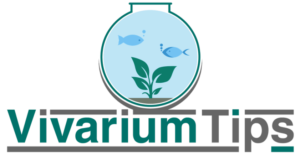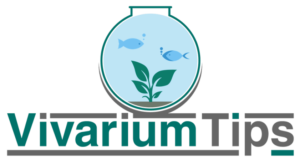Bearded dragons are Australian reptiles that are fun to keep as a pet. As they have evolved to live in habitats that are closest to humans, they can easily adapt to living with you.
They thrive mostly in woodlands and shrublands; therefore, if you want to keep them as a pet, you might want to give them the same natural environment to live in.
So what exactly is the best substrates for bearded dragons?
One thing you must do is choose a good substrate for your bearded dragon.
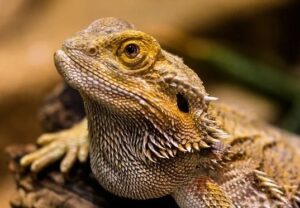
The market is flush with many kinds of substrates and you will get confused if you are just a newbie.
This buying guide will serve as a yardstick through which you can gauge out the best substrate for your bearded dragon.
I have also enlisted the best substrates you can buy in this buyers’ guide.
In this buyers’ guide, “Exploring The Best Substrate For Bearded Dragons,” you will learn:
- if bearded dragons need substrates or not
- the type of substrates that bearded dragons can use
- cost-effect substrate alternatives for bearded dragons
- the best substrates for your bearded dragon
- pros vs. cons
- loose substrate
- sand substrate
Ready to find the perfect substrate for your bearded dragon?
Disclaimer: There may be Amazon affiliate links on VivariumTips.com – When users purchase through an affiliate link, there will be no additional cost to the purchaser. Instead, I will earn a commission from your purchases.
You can use this filter below to find the best substrates for your paludarium!
Finding The Right Substrates For Bearded Dragons
| ➡️ List of Substrates Below | Trap In Substrate | Feeders Hiding | Dry Skin | Causes Irritation | Sticks To Wound/Skin | Nutritional | Associated With Impaction | Creates Odor | Creates Growth of Pathogen | Hard To Clean | Poor Stimulation - Stress Reduction If Likely |
|---|---|---|---|---|---|---|---|---|---|---|---|
| ➡️ Tiles | Unlikely | Unlikely | Unlikely | Unlikely | Unlikely | Unlikely | Unlikely | Unlikely | Unlikely | Unlikely | Unlikely |
| ➡️ Linoleum | Unlikely | Unlikely | Unlikely | Unlikely | Unlikely | Unlikely | Unlikely | Unlikely | Unlikely | Unlikely | Unlikely |
| ➡️ Artificial Grass | Likely | Unlikely | Unlikely | Unlikely | Unlikely | Unlikely | Unlikely | Likely | Likely | Possibly | Likely |
| ➡️ Reptile Carpet | Likely | Unlikely | Unlikely | Unlikely | Unlikely | Unlikely | Unlikely | Likely | Likely | Possibly | Likely |
| ➡️ Gravel | Unlikely | Likely | Unlikely | Unlikely | Unlikely | Unlikely | Unlikely | Likely | Likely | Likely | Likely |
| ➡️ Wood Chips or Bark | Unlikely | Likely | Unlikely | Unlikely | Likely | Unlikely | Likely | Likely | Likely | Likely | Unlikely |
| ➡️ Walnut | Unlikely | Likely | Unlikely | Likely | Likely | Unlikely | Likely | Likely | Likely | Likely | Unlikely |
| ➡️ Paper Material | Unlikely | Likely | Unlikely | Unlikely | Possibly | Unlikely | Unlikely | Likely | Likely | Likely | Likely |
| ➡️ Clay Sand | Likely | Likely | Likely | Likely | Likely | Unlikely | Likely | Likely | Likely | Likely | Unlikely |
| ➡️ Children's Sand Clay | Unlikely | Likely | Likely | Likely | Likely | Unlikely | Likely | Likely | Likely | Likely | Unlikely |
| ➡️ Vita / Calci Sand | Unlikely | Likely | Likely | Likely | Likely | Likely | Likely | Likely | Likely | Likely | Unlikely |
| ➡️ Leaves | Unlikely | Likely | Unlikely | Unlikely | Possibly | Possibly | Unlikely | Likely | Likely | Likely | Unlikely |
| ➡️ Alfalfa or Lucerne Pellets | Unlikely | Likely | Unlikely | Possibly | Likely | Likely | Unlikely | Likely | Likely | Likely | Unlikely |
| ➡️ Corn Cob | Unlikely | Likely | Unlikely | Possibly | Likely | Unlikely | Likely | Likely | Likely | Likely | Unlikely |
| ➡️ Seeds | Unlikely | Likely | Unlikely | Possibly | Likely | Likely | Likely | Likely | Likely | Likely | Unlikely |
You can find all the products by clicking here.
Do Bearded Dragons Need Substrate?
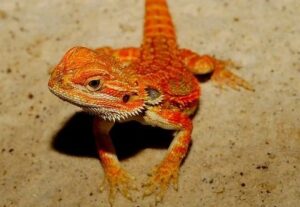
Yes, you need a substrate if you want to keep a bearded dragon as a pet. Without a substrate, your pet will be left on the plain glass which is miles away from its natural habitat.
Imagine that you are forced to live in a house with a floor made of ice or a floor of shrubs and grass – pretty inconvenient, right?
Although these animals are tough and can live in just about any environment, you are going to subject them to discomfort without any kind of substrate.
Not only it is inconvenient for them, but it is all the more boring as there is no environment for them to adapt to.
No grass, no rocks, and no sand make your pet miss its natural surroundings.
If you don’t know what a substrate is, it is a layer that you put at the bottom of your dragon’s living area.
Every kind of substrate serves a different purpose.
Common Types Of Substrates
The most common type of substrate used is:
- clay
- sand
- rocks
- tiles and newspapers are also used sometimes
If you use a natural substrate then, in addition to making the area feel more realistic, it also provides your dragon with a lot more steady ground to walk on.
They are also useful for regulating the internal temperatures and removing the humidity.
Furthermore, if you are using a substrate like sand, then it allows your dragon to engage with its environment as they can bury themselves in the sand which is similar to what they are used to in the wild.
Types Of Substrates For Bearded Dragons
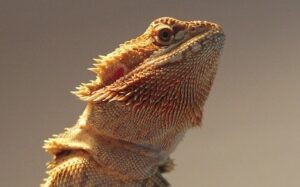
The five types of substrates that can be used for bearded dragons are:
- sand
- cage liners
- clay
- newspaper
- tile
Here’s what you need to know about each type of substrate.
Sand
Non-silica based sand substrates go well with bearded dragons. Normally you don’t have to worry about ingestion; however, baby dragons can ingest such materials easily.
Some safer sand substrates are made of calcium and are easily digestible.
Just to be safe, I advise you to avoide using sand as substrate for baby dragons.
The reason for this is that calcium-based sand can be metabolized if the juvenile bearded dragons ever swallow it.
Cage Liner
Cage liners are carpet-like mats that are made to look like real grass or have a sandy texture. Liners are the most convenient choice and are very economic.
They have smooth textures but some are rough.
They are rolls of carpets that can be cut to your preferred size so it makes them very simple to handle.
They are most easily washable and reusable as well; hence, they provide you the best value.
Clay
Clay allows you to make a natural habitat for your dragon and lets them build burrows for themselves as they would if they were out in the wild.
Clay is mixed with water to give it its shape.
You can make flat ground, tunnels, and burrows for them and your imagination is your only limit.
It retains its shape after getting firm and there is an added advantage to using clay as you don’t have to worry about your dragon ingesting it.
You can also use another substrate as well as natural plants along with the clay.
Newspaper
Newspapers are a simple and cost-effective substrate alternative to line the bedding of the tank.
It doesn’t have any aesthetics to it and definitely will not make your tank one of the best looking, but it is good for baby dragons as it protects against the ingestion of the substrate.
The only catch is that you will have to change it very often and probably every day.
Tile
Tiles are rarely used but they are an effective and long-lasting substrate.
I advise using textured tiles so that your pet won’t have trouble anchoring its feet to the ground.
Furthermore, ceramic tiles are hard and can be harsh for the feet of a baby dragon.
Ceramic tiles also require regular maintenance and are not easy to change.
Cost-Effective Substrate Alternatives for Bearded Dragons
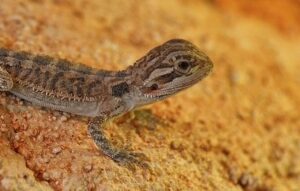
The most cost-effective substrate alternatives for bearded dragons are:
- slate tiles
- lino
- artificial grass
- newspapers and paper towels
- reptile carpet
Let’s go a little further in-depth about these alternatives.
Slate Tiles
Tiles are best for easy cleaning and keeping the tank sanitized. It is best for all types of reptiles including bearded dragons. The good thing about tiles is that they can either be used as a standalone substrate or as a base for other substrates.
They have two advantages:
- the main floor doesn’t get too dirty
- you always have a surface available when you are using it with another substrate
You need to be very careful while installing tiles and make sure that there is no space left between the tiles as water can seep through and cause insects and all sorts of unwanted things to accumulate there.
Once you have installed the tiles, it is the easiest to clean and helps prevent diseases from spreading.
The biggest disadvantage of tiles is that:
- the surface is slippery and it offers almost no grip to the dragon’s feet; therefore, it is recommended to use it with a separate substrate.
Lino
Lino is almost the same as tiles and, just like tiles, it offers little to no grip at all. Be sure to keep it away from sunlight as much as possible.
Artificial Grass
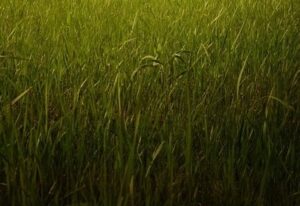
Artificial grass is a great choice for aesthetics as well as an all-rounder beautiful looking floor. It is a great option to use with tiles to give a more versatile look to the dragon’s habitat.
Artificial grass is also very easy to clean; just rinse it with cold water and give it a couple of wipes and you are all good to go.
I advise choosing a turf that has an easy to clean backing.
A little bit of a disinfectant solution is also useful for sanitizing the grass.
Keep in mind that cleaning the artificial grass is necessary. If it not cleaned timely, then it can smell bad.
Furthermore, it tends to get very hot, especially when placed under a light. It can get too hot to even touch and can prove to be hazardous to your pet.
Newspaper And Paper Towels

Newspapers and toilet papers are a great choice for a substrate for baby bearded dragons. Firstly, they are soft and will not cut the feet of the dragon, and second, they are very cost-effective.
You can replace the substrate with the daily newspaper and it won’t cost you any additional penny.
With that being said, the benefits are purely human-centric and will only benefit the dragon up to soft bedding.
If any kind of illness spreads in the tank, you are going to have to replace it now and then to make sure that you don’t make your pet sicker. The papers are very light and are very easily torn apart.
Small chunks can, therefore, be ingested by the dragon with the food.
Furthermore, with toilet paper, your pet will get bored soon.
It doesn’t provide any activity for your dragon as it doesn’t even remotely look anything like a natural habitat, and second, feeding the dragon in such a substrate is a problem as the insects tend to hide inside the paper and it is difficult for the dragon to eat.
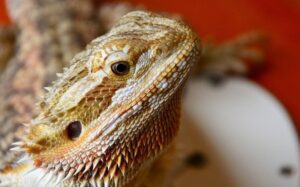
Reptile Carpet
Reptile carpet is used by people who want an easy to clean substrate and do not have a lot of time to invest in the cleaning. It is very easy to remove and install.
You can spot clean the carpet and wash it whenever you feel like it is dirty.
Once done cleaning with a pressure hose, wash it with a disinfectant then rinse it with water.
I advise against washing it in a washing machine.
You might find that smell accumulates rather quickly when using these carpets; well, you are not the only one as many people have complained about it being an underlying issue while using these carpets.
The best thing to do is to keep washing it and apply some freshener.
Best Substrates For Bearded Dragons
Below, you can find the best substrates for bearded dragons! Feel free to comment below this article if you have any recommendations!
#1 Zilla Reptile Terrarium Liner
Zilla substrate is a cost-effective and high-quality bedding liner for your bearded dragon.
It comes in a rolled shape that you can cut to your preference; this prevents waste as well.
The felt is made of a non-abrasive material that is soft and won’t give your dragon problems while moving. It will be tender for its feet.
It also comes with absorbent capabilities so you don’t have to worry about any kind of bad odor as it comes with activated enzymes that help to maintain a clean and healthy environment by breaking down bacteria and other odor-producing agents.
To clean, you just have to rinse it with cold water. You can reuse the substrate multiple times. The quality is really good and it feels durable enough. You can even scrub it with soap without any issues.
This substrate is one of the best choices for baby dragons because your pet can’t eat it; therefore, it is one of the safest ones out there.
It is available in two different colors so you can get whichever suits your surroundings.
Model Number: 100111759
[i2pc pros_icon=”icon icon-thumbs-o-up” cons_icon=”icon icon-thumbs-o-down” show_title=”true” title=”Pros & Cons” use_heading_icon=”0″ show_button=”true” pros_title=”Pros” cons_title=”Cons” link_text=”Check Price on Amazon” link=”https://amzn.to/3i5VXyG” ][i2pros]Highly durable
Comes in one piece
Inedible
Prevents bad odors
Activated enzymes[/i2pros][i2cons]Grains are a bit large
May be somewhat small for bigger tanks[/i2cons][/i2pc]
#2 Zilla Ground English Desert Walnut Shells
If you want to give a realistic desert-like environment to your dragon, then the Zill Ground English Desert Walnut Shells are something worth considering.
This substrate is made up of natural and pure walnut shells that are ground to a fine size.
The texture and grainy feel combined with its color recreate the desert environment. It is also good for giving your bearded dragon something to do as it can dig and burrow itself just like it would in its natural habitat.
If you use actual sand, it will scratch the glass of your tank; but this material is soft and will not be harsh. You can already tell that it will be gentle for your dragon’s feet as well.
I would advise making a thick layer of about 2 inches at least for a baby dragon so it can dig with ease.
You can purchase up to 25-quart bags for the amount you need.
For one bedding, you will only need a one-time replacement in one month; this means that one bag should last for a long time.
Furthermore, this material is natural so you can use it for other purposes as well.
Model Number: 11763
[i2pc pros_icon=”icon icon-thumbs-o-up” cons_icon=”icon icon-thumbs-o-down” show_title=”true” title=”Pros & Cons” use_heading_icon=”0″ show_button=”true” pros_title=”Pros” cons_title=”Cons” link_text=”Check Price on Amazon” link=”https://amzn.to/3gtEG1U” ][i2pros]Affordable
Can go up to a month with one bedding
Beautiful aesthetic appeal
Prevents odors
Allows digging[/i2pros][i2cons]Extra porous texture makes it soggy
The dragon can outgrow the grain size for effective digging[/i2cons][/i2pc]
#3 Zoo Med Excavator
Bearded dragons are known to be playful and all they want to do is eat, dig, and sleep. The Zoo Med Excavator Clay helps simulate the same experience for them.
As it is natural clay, the tunnels your dragon makes will stay put.
It can make multi-level tunnels depending upon the quantity of substrate you put in the glass; this gives them the same experience as their natural habitat.
The good thing about this substrate is that it is 100% natural and is free from all chemicals, colors, or dyes.
Before putting it inside, you will have to mix it with water and wait for it to get firm. Once it’s solid, your dragon will not be able to ingest it.
If you see some dirt or unnecessary things accumulating, you can spot clean it. It does try to prevent odor, but once it is saturated, you will need to replace it.
If you are using a heat lamp, I would advise to monitor it now and then as exposure to heat will make it dry out quickly.
Model Number: XR10
[i2pc pros_icon=”icon icon-thumbs-o-up” cons_icon=”icon icon-thumbs-o-down” show_title=”true” title=”Pros & Cons” use_heading_icon=”0″ show_button=”true” pros_title=”Pros” cons_title=”Cons” link_text=”Check Price on Amazon” link=”https://amzn.to/3fAz2tD” ][i2pros]Gets firm quickly
Fit for digging and making burrows
Mimics a natural habitat
Does not require much maintenance[/i2pros][i2cons]Tends to get saturated very fast
Drys out quickly[/i2cons][/i2pc]
#4 Zoo Med ReptiSand
ReptiSand is finely grained sand that is very good for burrowing. Although it is fine and powder-like, it doesn’t create any dust. To engage your dragon in burrowing activities, this is a great choice.
Made with some of the finest quartz sand with no preservatives or chemicals, this substrate stands out for its quality.
It is a good choice for adult bearded dragons but might not be a good choice for juvenile dragons who are prone to ingesting sand along with their food.
It has a light white color and gives a desert-like appearance. It is also a good conductor of heat.
I recommend filling up the tank with it to about 2 inches.
Although it is sand, you can clean it and use it as many times as you want.
It may get a little tedious but it is worth it especially if you are on a budget. The reusability factor will help you save a lot of money.
Model Number: SW05
[i2pc pros_icon=”icon icon-thumbs-o-up” cons_icon=”icon icon-thumbs-o-down” show_title=”true” title=”Pros & Cons” show_button=”true” pros_title=”Pros” cons_title=”Cons” link_text=”Check Price on Amazon” link=”https://amzn.to/3khkbYG” ][i2pros]Reusable
Fit for making burrows
White desert-like appearance
Finely grained sand
No preservatives[/i2pros][i2cons]Not a good choice for baby dragons
Can be easily ingested with food[/i2cons][/i2pc]
#5 Reptile Sciences ProCalcium Sand
If you want something that is natural and closer to bearded dragons’ natural habitat, then Reptile Sciences ProCalcium Sand is worth giving a shot.
This substrate is a pure calcium carbonate material that is a requisite part of a dragon’s natural habitat.
Calcium carbonate has many benefits: it lowers pollution and is a natural filter that will help you maintain a clean environment for your pet.
The fine granular texture helps reduce the risk of a baby dragon ingesting the substrate with its food, so you don’t have to worry about the digestive health of your dragon.
The texture is also very soft so it won’t be harsh for your dragon’s feet.
Baby bearded dragons are especially prone to cuts and abrasions; this will make sure that your baby dragon has it easy.
The best thing about this substrate is that it is a waste regulator.
The substance sticks to the dirt and prevents your pet from spreading it everywhere around the tank.
The material forms lumps of waste and you can easily identify and remove it.
Furthermore, it comes with strontium which reduces the odor to a bare minimum and keeps the tank clean and healthy.
Model Number: 81110
[i2pc pros_icon=”icon icon-thumbs-o-up” cons_icon=”icon icon-thumbs-o-down” show_title=”true” title=”Pros & Cons” show_button=”true” pros_title=”Pros” cons_title=”Cons” link_text=”Check Price of Amazon” link=”https://amzn.to/3ks8Vc6″ ][i2pros]Calcium carbonate substrate
Natural filtration mechanisms
Granular texture
Abrasion resistance
No preservatives[/i2pros][i2cons]May not be good for a big dragon
Not a very high-end substrate[/i2cons][/i2pc]
#6 ZooMed Eco Carpet
If you want something that is washable and easy to clean, then give ZooMed Eco Carpet a try.
If you don’t have a lot of time to invest in cleaning the tank and want a substrate that doesn’t require scooping now and then with no risk of your reptile ingesting the substrate with its food, then this is a great choice.
This substrate is very eco-friendly and convenient to use. The carpet is soft and abrasion-resistant; therefore, it will be very comfortable for your pet to walk on and will prevent any cuts.
This substrate is made from recycled bottles in a very controlled environment; this is partly the reason why it is so cost-effective.
It can be cut to any size you want and most of the bigger tanks will easily accommodate this substrate.
Even if your tank is of an irregular shape, you can cut this substrate to match the shape of your tank.
Model Number: ET55
[i2pc pros_icon=”icon icon-thumbs-o-up” cons_icon=”icon icon-thumbs-o-down” show_title=”true” title=”Pros & Cons” show_button=”true” pros_title=”Pros” cons_title=”Cons” link_text=”Check Price on Amazon” link=”https://amzn.to/3fw0b0D” ][i2pros]Reusable
Cost-effective
Good for aesthetics
Soft surface
Washable[/i2pros][i2cons]Does not provide any digging options for your pet
Made from plastic recycled bottles[/i2cons][/i2pc]
#7 Hamiledyi Reptile Carpet Mat
Do you want something natural yet carpeted? If yes, then we have got the product for you. Check out the Hamiledyi Reptile Carpet Mat that is made from natural coconut fiber.
It is a natural material that is found mostly in tropical areas. It is completely natural, healthy, and safe for your pet.
It is soft and non-abrasive. The substrate goes well with baby dragons as it doesn’t harm their soft feet. As it is fiber, it helps maintain the overall environment of the tank and keeps it clean. It absorbs moisture so it is great for reducing the humidity levels in the tank, providing much more room for air.
Cleaning this mat is also very easy as you just need to rinse it with cold water and it will be ready to use again.
The package comes with two large sheets that you can cut to fit your tank.
Keep in mind that the material tends to absorb heat; if you are trying to regulate the temperature through an artificial lamp, you will need continuous monitoring as the overall temperatures will likely be higher than intended.
[i2pc pros_icon=”icon icon-thumbs-o-up” cons_icon=”icon icon-thumbs-o-down” show_title=”true” title=”Pros & Cons” show_button=”true” pros_title=”Pros” cons_title=”Cons” link_text=”Check Price on Amazon” link=”https://amzn.to/3i8GUUI” ][i2pros]Reusable
Natural coconut fibers
Non-abrasive
Moisture absorbing
Washable[/i2pros][i2cons]Absorbs heat
Can increase humidity[/i2cons][/i2pc]
#8 Zoo Med Cage Carpet
The Zoo Med Reptile Cage Carpet is a budget-friendly substrate that is made from recycled materials.
The texture is soft and moisture absorbent. The surface prevents any accidental ingestion and is great for muscle development as the dragon can easily anchor its feet to the surface.
Coming with two large sheets, this is fit for a sixty-gallon tank.
You can easily cut it and adjust it according to your needs. You can also use another substrate on top of this one to provide some room for digging.
I like the reusability of this substrate as it is very easy to wash and reuse. The best way to clean it is to soak it in warm water and wipe it out.
To keep odors to a bare minimum, we advise cleaning it once a week so that your pet can stay clean and healthy.
Model Number: 26083
[i2pc pros_icon=”icon icon-thumbs-o-up” cons_icon=”icon icon-thumbs-o-down” show_title=”true” title=”Pros & Cons” show_button=”true” pros_title=”Pros” cons_title=”Cons” link_text=”Check Price on Amazon” link=”https://amzn.to/3fGaLTb” ][i2pros]Easy washing
Budget-friendly substrate
Soft material
Moisture absorbent
Fit for bigger tanks[/i2pros][i2cons]Requires maintenance
Tends to smell if not taken care of properly[/i2cons][/i2pc]
#9 Critters Comfort Reptile Bedding
If you prefer a loose substrate but still want coconut fiber, then Critters Comfort Reptile Bedding is a good alternative.
It doesn’t come with a carpet design and you can make your bedding for your pet. It is made of real non-toxic coconut fiber that is free from all sorts of chemicals.
The good thing about this substrate is that it is incorporated with some sort of enzymes that not only absorb the odor but also break down the odor-producing agents, keeping your tank fresh.
The substrate can be ingested by baby dragons, but that is nothing to worry about as it is digestible and harmless.
Your baby dragon is going to love walking on it and digging in it as the texture is soft and smooth. It provides adequate cushioning and good insulation from heat. The full-size bag should last you for quite some time.
With this substrate, I recommend cleaning and replacing it every month.
Furthermore, as it is natural coconut, you can make some great composts out of it.
[i2pc pros_icon=”icon icon-thumbs-o-up” cons_icon=”icon icon-thumbs-o-down” show_title=”true” title=”Pros & Cons” show_button=”true” pros_title=”Pros” cons_title=”Cons” link_text=”Check Price on Amazon” link=”https://amzn.to/3a0QaHF” ][i2pros]Affordable
Digestible material
Free from chemicals
Insulator[/i2pros][i2cons]The dragon can ingest it with food
Not suitable for juvenile dragons[/i2cons][/i2pc]
#10 Zoo Med Eco Earth Coconut Fiber Substrate
Zoo Med Eco is a great choice for a natural-looking habitat. It is made from natural materials that are good at absorbing odors and moisture.
Furthermore, it breaks down odor-creating agents to keep the tank fresh and clean.
The surface makes it very easy to clean.
You might need to remove the waste daily and replace the substrate very often but at this price, this is worth it.
Furthermore, I also advise that you completely replace it every six months.
It comes in a finely ground powder form which means it can be ingested by baby dragons.
It also comes in various sizes so you can choose the one that suits your needs the best.
Model Number: EE8
[i2pc pros_icon=”icon icon-thumbs-o-up” cons_icon=”icon icon-thumbs-o-down” show_title=”true” title=”Pros & Cons” show_button=”true” pros_title=”Pros” cons_title=”Cons” link_text=”Check Price on Amazon” link=”https://amzn.to/33w4pTK” ][i2pros]Looks natural
Digestible finely grained material
Easy to clean
Comes in various sizes[/i2pros][i2cons]Ingestible
Can smell if not cleaned every week[/i2cons][/i2pc]
Pros and Cons of Using Different Substrates
Here are the pros and cons when using different substrates for bearded dragons.
This section will cover:
- grass as substrate
- loose substrate
- sand as substrate
Using Living Grass As A Substrate
So, how about using real grass?
Does it make any difference?
A lot of people are concerned about how safe it is. I am glad to tell you that you can use grass without worrying too much.
Try adding some dandelions and it will be a natural food for it. Real grass is somewhere between a substrate and a substrate accessory.
If you intend to use real grass, there are a few things you need to take care of.
Since there is going to be soil with it, it is best to use untreated soil – a soil that is free of all the chemicals and fertilizers.
Baby dragons are sensitive to chemicals like that and long exposure may cause health issues.
Furthermore, the soil should be free of any kind of parasites that will affect the natural habitat.
While your dragon may happily snack on bigger bugs, small pests such as termites can cause problems.
Always keep multiple trays ready as it allows for easy replacing and prevents the build-up of unhealthy bacteria.
You might have to test this out a bit yourself first because changing the trays will depend on the grass type, frequency of usage, and other factors.
Using A Loose Substrate
What kind of substrate will be the most suitable for your pet depends on its health and age.
There are some complications like problems laying eggs if not provided in the right environment.
Females are known to retain their eggs and will not lay them until they are provided with sand to dig themselves in and finally lay their eggs.
Loose substrates are best used in combination with some other type of housing material.
I don’t recommend spreading the loose substrate all over and use it as a standalone.
The dry environment can make ingestible chunks and excessive humidity can be caused by porous substrates which can absorb fluids that can further contribute to causing health issues.
Some issues that come with using a loose substrate are:
- These substrates can be easily consumed by babies and can cause some serious complications if their digestive system is blocked.
- Loose substrates are often for one-time use and cannot be cleaned. Some of them can be cleaned but they require extensive effort which is just not worth the time.
- Substrates like those made from walnut are breeding grounds for harmful pathogens.
- If you feed the dragon with live insects then there will be a lot of opportunities for the insects to hide and attack it later.
- Loose substrates can also get to areas such as wounds and eyes and cause contamination and infection.
- Some of the fine substrates produce dust which is hazardous to health.
Let’s get one thing clear here: a substrate requires cleaning and replacement. Cleaning involves removing debris, cleaning of the ground, and finally disinfecting.
You should also know that while some substrates that are made up of edible materials like coconut are unlikely to cause any harm if ingested in small amounts; none of the other substrates are safe to eat even if the manufacturer claims so.
Even if the item is edible, there are hygienic concerns which can create a plethora of problems.
So what to do if your dragon is ingesting the substrate?
Here are some tips:
- Only put the substrate in a small area like where you intend for the dragon to dig.
- If you can’t do that and have to spread it on the floor, try changing your feeding location to a place that doesn’t contain any substrate.
- Look for stress indicators like trying to get out of the glass, running away when it sees you, hitting on the glass walls. Stress can cause behavioral changes in dragons which can cause them to exhibit an unusual type of appetite.
- Pay special attention to diet. There is a possibility that your dragon is lacking in nutrients and is naturally trying to compensate for that deficit.
With that being said, even after taking all the necessary precautions, there is still some substrate that is going to land in your dragon’s stomach.
The best workaround is to get a calcium carbonate substrate.
Even though we still think it is unsafe to ingest, but at least it compensates by making up for a calcium deficiency.
Using Sand As A Substrate
There is a lot of variety when it comes to sand, like desert sand, calcium sand, river sand, beach sand, etc.
It provides a more natural look to your tank and gives the dragon more opportunities to blend in. The dragon can perform digging activities and speed up its muscle development.
Did you know?
Sand is also good at absorbing moisture.
You can use children’s sand as a substrate without much issue; in fact, it may be the best kind of sand you can use as a substrate as it is seldom ingested.
Desert sand is also a similar choice that can get wet and gives the ability to dig tunnels.
As for children’s sand:
- it has a more rounded and grainy texture
- it has lesser abrasion than the other sands
- it holds most of its shape when it gets dry after getting moist.
But if you compare it with desert sand, desert sand holds up much better than the playing sand. They should at best be avoided as they are sharp and very abrasive.
While it may not be an ideal choice for an all-ground spread, it is a nice choice for a digging box. This keeps the rest of the ground free from sharp sand.
If you want to use desert sand, I advise using white sand as it is much smoother than red sand.
There are some disadvantages to using sand.
If it gets stuck on the food and accidentally gets ingested, there is a high chance of impact.
Even though bearded dragons are used to living in a sand-filled environment, they are not used to living in a confined space.
This limits room for air and accumulates dust that might cause respiratory difficulties for your bearded dragon.
A combination of two or more substrates and using sand which is not so finely grained can help prevent these issues.
FAQ For Substrates And Bearded Dragons
I have listed some of the most frequently asked questions about substrate for bearded dragons as well as their answers down below:
What is the best substrate for a bearded dragon?
It depends on your preference. We have enlisted a wide range of products from which you can choose the best for yourself.
What do substrates get soggy?
Porous substrate tends to get soggy due to its moisture absorbing capabilities.
Is calcium substrate any good?
It is not only good but is by far the safest of the substrates you can use.
What is the proper way to feed bearded dragons?
Bearded dragons are ardent eaters so you have to make sure that you feed them away from the substrate. They tend to eat fast and take the substrate along with the food. It is very important to feed them away from the substrate so they don’t gobble down the substrate with their food.
How to quickly clean the substrate in your bearded dragons’ tank?
It is essential to give your pet a clean and healthy environment, so you will need to allocate some time to your pet’s cleaning routine. If you can’t spare a lot of time, then you better buy something that is easy to clean and manage.
Top Recommendation
I have provided some of the most high-quality products in my reviews and I think that Zilla Reptile is the best amongst them.
There are a few good reasons as to why I chose that as my top pick.
First, there is no waste and it is reusable as well and, unlike most of the products on this list, you can cut it to your preferred size and use the right size you need. Also, it is fully washable and you can rinse it with water to clean it and let it dry.
Other substrates don’t give you this luxury of choice.
Furthermore, I also like the color options you get with this substrate as it comes in both green and brown colors. You can easily make your habitat look either like grassy woodlands or a desert.
Also, you don’t have to worry about your pet eating it; so even if you have a baby dragon, you can feed it without worrying.
From VivariumTips,
These small reptiles are an amazing pet to have in a sense that they are tough and don’t require too much attention; this means that they are low maintenance pets.
Therefore, to make your experience more pleasant with them and to increase their comfort, it is necessary to choose the right substrate.
Choosing the right substrate not only helps in the healthy development of your pet but also keeps it away from a lot of other diseases.
We would advise you to be careful about baby dragons, however. They are delicate and special care needs to be given to their habitat and their diet.
Small dragons tend to eat everything and may eat it with their food.
Therefore, I have provided a detailed buying guide on how to choose a substrate and have provided the best substrates for bearded dragons you can buy.
Reptile brand mentioned in this article:
- Zilla
- Zoo Med
- Reptile Sciences
- Hamiledyi
- Critters Comfort
Hopefully, this article serves you well.
If you enjoyed this buyers’ guide, “Exploring The Best Substrates For Bearded Dragons,” be sure to check out my other related articles:
- What Does It Mean When A Bearded Dragon Licks You?
- I Left My Bearded Dragons’ Lights On All Night! (Solved)
- Can I Leave Crickets With My Bearded Dragon Overnight?
For any questions, comment below and I’d be glad to answer it as soon as possible. 🙂
